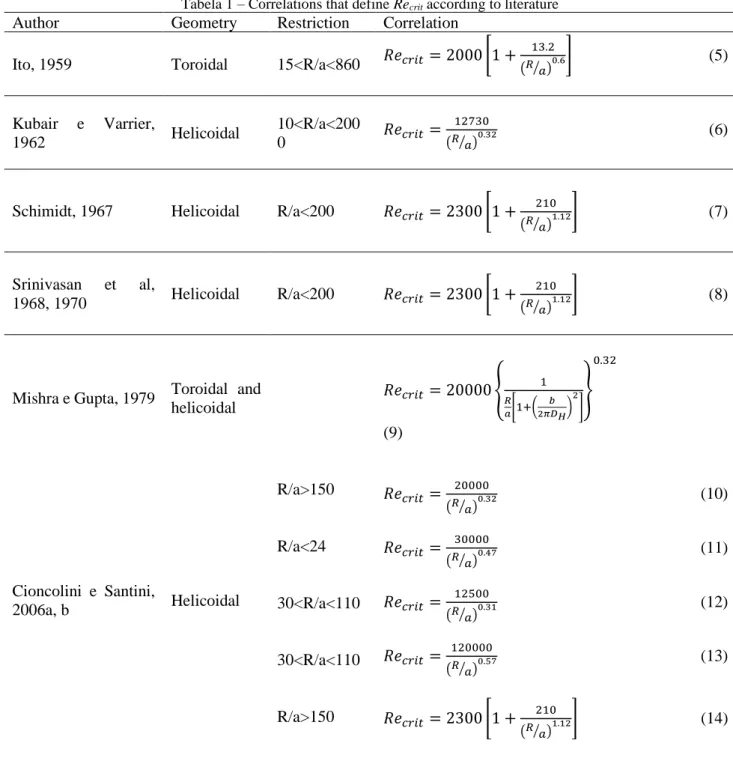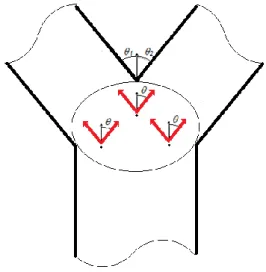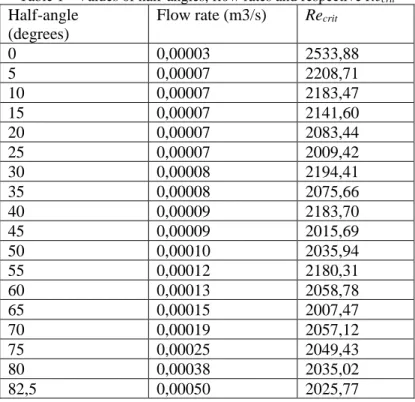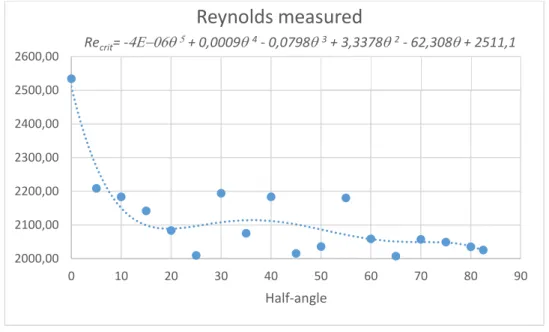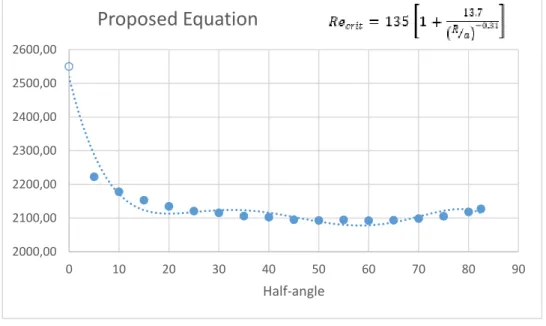Braz. J. of Develop.,Curitiba, v. 6, n. 9, p.71074-71085,sep. 2020. ISSN 2525-8761
Critical Reynolds number in bifurcations
Numero de Reynolds Critico em Bifurcações
DOI:10.34117/bjdv6n9-522
Recebimento dos originais: 08/08/2020 Aceitação para publicação: 22/09/2020
Flavio Peres Amado Higher academic education: D.Sc.
Full Professor, Department of Mechanical Engineering
Universidade Estacio de Sá, Rua Eduardo Luiz Gomes, 134 - Morro do Estado, Niterói - RJ, 24020-340,
E-mails: flavioam@petrobras.com.br; fpamado@live.estacio.com.br Victor Hugo Corradi Mondaini
Education: Student of the Mechanical Engineering Department
Universidade Estacio de Sá, Rua Eduardo Luiz Gomes, 134 - Morro do Estado, Niterói - RJ, 24020-340,
Braz. J. of Develop.,Curitiba, v. 6, n. 9, p.71074-71085,sep. 2020. ISSN 2525-8761 ABSTRACT
During the last four years, the authors and collaborators have been developing work to survey characteristics of thermal and fluid dynamics at the entrance of bifurcations under laminar regime. Equations were established that intend to predict the extension of the thermal and flow developing regions, depending on the variation of angles, flow rates and diameters, based on a CFD type simulation, which uses an in-house code employing finite difference method and also through commercial softwares. This time, authors intend to increase the knowledge about flow in bifucations by raising equations that predict the Critical Reynols Number. The specialized literature states that the Critical Reynols Number for toroidal and helical geometries is a function of the radius of curvature and the inner radius of the tube that makes up these structures. In the presente work, this equation format was customized for bifurcations, similar to the manner the authors employed in them previous articles. As a bifurcation has no radius of curvature, each outlet is considered to be an approximately toroidal curve, with a radius calculated according to the formulation proposed also in previous papers by the authors. The correlation achieved is based solely on numerical simulation results. The velocity values from which the flow changed from laminar to turbulent were noted and used to calculate the respective Reynolds Number values. Such data were gathered to establish an expression that exclusively served the sample universe of this research. However, consistent experimental results are expected for future works in which it is intended to confirm the conclusions previously established from computer simulation.
Keywords: Critical Reynolds Number, Entrance Region, Bifurcations RESUMO
Durante os últimos quatro anos, os autores e colaboradores têm vindo a desenvolver trabalhos de levantamento das características da dinâmica térmica e fluida à entrada de bifurcações em regime laminar. Foram estabelecidas equações que pretendem prever a extensão das regiões de desenvolvimento térmico e de escoamento, dependendo da variação dos ângulos, taxas de escoamento e diâmetros, com base numa simulação do tipo CFD, que utiliza um código interno empregando um método de diferença finita e também através de software comercial. Desta vez, os autores pretendem aumentar o conhecimento sobre o fluxo em bifucações através do levantamento de equações que prevêem o Número Crítico de Reynols. A literatura especializada afirma que o Número de Reynols Crítico para geometrias toroidais e helicoidais é uma função do raio de curvatura e do raio interior do tubo que compõe estas estruturas. No presente trabalho, este formato de equação foi personalizado para bifurcações, à semelhança da forma como os autores empregaram nos artigos anteriores. Como uma bifurcação não tem raio de curvatura, cada saída é considerada como uma curva aproximadamente toroidal, com um raio calculado de acordo com a formulação proposta também em artigos anteriores pelos autores. A correlação obtida baseia-se unicamente em resultados de simulação numérica. Os valores de velocidade a partir dos quais o fluxo mudou de laminar para turbulento foram anotados e utilizados para calcular os respectivos valores numéricos de Reynolds. Tais dados foram recolhidos para estabelecer uma expressão que serviu exclusivamente o universo da amostra desta pesquisa. No entanto, esperam-se resultados experimentais consistentes para trabalhos futuros nos quais se pretende confirmar as conclusões previamente estabelecidas a partir da simulação em computador.
Braz. J. of Develop.,Curitiba, v. 6, n. 9, p.71074-71085,sep. 2020. ISSN 2525-8761 1 INTRODUCTION
In the last four years, the authors, together with co-authors from partner institutions, has developed research that involves analyzing the pressure drop and the behavior of the so-called regions of thermal and flow development in bifurcations. Six complete articles (Avelino et al 2016, Amado et al, 2018a, b, c, and Amado et al, 2019a, b) and five abstracts (Amado et al, 2017, Amado et al, 2018d, and, Amado et al 2019c, d) were published in several proceedings of national and international mechanical science events. Mathematical correlations were raised and tested under conditions of variation of the different quantities that influence the studied phenomena.
Continuing on the path followed until now, the proposal this time is the survey of critical Reynolds Number values for bifurcations.
As the classical literature shows, described among other sources by Pepe, 2018, The Reynolds Number, Re, is employed in fluid mechanics to represent the relationship between inertia forces and frictional forces in terms of dimensional parameters. For Newtonian fluids, the Reynolds Number will be determined using Eq. (1).
𝑅𝑒 =𝜌𝑣𝐷
𝜇 (1)
where, ρ is density, v velocity, D is the diameter of the parent duct and μ is the dynamic or absolute viscosity.
For non-Newtonian fluids (not covered in this work), Metzner-Reed, 1955, presented a generalized Re, where for fluids with index n = 1, this equation becomes the constitutive equation of a Newtonian fluid. For n <1, the fluid has pseudoplastic property and for n> 1 the fluid has dilating property.
𝑅𝑒 = 44−3𝑛𝜌𝑄2−𝑛
𝜋2−𝑛𝑘𝐷4−2𝑛(3𝑛+1 4𝑛 )
𝑛 (2)
where, Q is the volumetric flow rate, k is the consistency index and n is the power index. In an excellent review to raise correlations of prediction of variables involving pressure drop and heat transfer in tubes, Ghobadi and Muzychka, 2016, made a compilation of expressions, indicated as Eq. (5) to (14), which define the critical Reynolds number, Recrit, for toroidal and helical
Braz. J. of Develop.,Curitiba, v. 6, n. 9, p.71074-71085,sep. 2020. ISSN 2525-8761
internal radius of the tube. It has been noted by the various authors cited there that the secondary flow caused by the curvature of the tube stabilizes the laminar flow, resulting in a higher Recrit.
In the previous works of the authors, cited in the first paragraph of this manuscript, it has been postulated that expressions of prediction of physical quantities in bifurcations may originate from those established for curved stretches of pipe. In this context, it is intended to establish correlations in the shape of Eq. (3), where c1, c2 and c3 are constants that should be raised with the aid of CFD technique, where physical properties and dimensional characteristics that influence the
Recrit will be varied, in processes whose mechanistic equations that govern the hydrodynamic
phenomenon will be discretized into finite differences.
𝑅𝑒𝑐𝑟𝑖𝑡 = 𝑐1[1 + 𝑐2
(𝑅 𝑎⁄ )𝑐3] (3)
In Eq. (3), as bifurcations are not exactly conventional curves, in Amado et al 2018a, it was proposed Eq. (4) to define R.
𝑅 = 1200.5𝐷𝑅𝑒0.66
𝜃2 (4)
Where D is the diameter of the pipe that the bifurcation is made of, Re is the number of Reynolds calculated for the simulated flow and θ is the half-angle of the outlet.
Thus, the work proposal would be, as stated, the survey of correlations to define Recrit in
Braz. J. of Develop.,Curitiba, v. 6, n. 9, p.71074-71085,sep. 2020. ISSN 2525-8761
Tabela 1 – Correlations that define Recrit according to literature
Author Geometry Restriction Correlation
Ito, 1959 Toroidal 15<R/a<860 𝑅𝑒𝑐𝑟𝑖𝑡= 2000 [1 +
13.2 (𝑅 𝑎⁄ )0.6] (5) Kubair e Varrier, 1962 Helicoidal 10<R/a<200 0 𝑅𝑒𝑐𝑟𝑖𝑡= 12730 (𝑅 𝑎⁄ )0.32 (6)
Schimidt, 1967 Helicoidal R/a<200 𝑅𝑒𝑐𝑟𝑖𝑡= 2300 [1 +
210 (𝑅 𝑎⁄ )1.12] (7) Srinivasan et al, 1968, 1970 Helicoidal R/a<200 𝑅𝑒𝑐𝑟𝑖𝑡= 2300 [1 + 210 (𝑅 𝑎⁄ )1.12] (8)
Mishra e Gupta, 1979 Toroidal and helicoidal 𝑅𝑒𝑐𝑟𝑖𝑡= 20000 { 1 𝑅 𝑎[1+( 𝑏 2𝜋𝐷𝐻) 2 ] } 0.32 (9) Cioncolini e Santini, 2006a, b Helicoidal R/a>150 R/a<24 30<R/a<110 30<R/a<110 R/a>150 𝑅𝑒𝑐𝑟𝑖𝑡= 20000 (𝑅 𝑎⁄ )0.32 (10) 𝑅𝑒𝑐𝑟𝑖𝑡= 30000 (𝑅 𝑎⁄ )0.47 (11) 𝑅𝑒𝑐𝑟𝑖𝑡= 12500 (𝑅 𝑎⁄ )0.31 (12) 𝑅𝑒𝑐𝑟𝑖𝑡= 120000 (𝑅 𝑎⁄ )0.57 (13) 𝑅𝑒𝑐𝑟𝑖𝑡= 2300 [1 + 210 (𝑅 𝑎⁄ )1.12] (14)
2 MATERIALS AND METHODS
In the authors previous works, it was taken as one of the premises, to consider computer simulations as absolutely representative of real experiments. Thus, the different flow schemes in bifurcations were simulated by finite differences (in a work that involved mathematical modeling, discretization, structured programming and image generation), as well as through a commercial CFD package. In the same way, in the present work, it is intended to elaborate “handmade” simulation schemes and also to carry out simulations by commercial codes, to identify the beginning of the undefined flow, however in an approach in which an elementary volume when considered
Braz. J. of Develop.,Curitiba, v. 6, n. 9, p.71074-71085,sep. 2020. ISSN 2525-8761
near the bifurcation, is faced with the possibility of following two paths. The area inside the ellipse shown in Fig. 1 is approximately the region of onset of instability caused by the bifurcation existing after the feeder tube. There, the elementary volume represented by each black dot can go in the direction of any of the branches. Thus, the initial conditions of velocity v could be vcosθn and
vsenθn, respectively in the axial and transverse directions, where θn is one of the bifurcation
half-angles (θ1 or θ2), according to the direction taken by the elementary volume.
Figure 1. Ellipse that approximately represents the region of instability, caused by the existence of a bifurcation after flow in a straight tube
In other words, the moment equations (taken in two dimensions - r as radial and z as axial), which govern the flow phenomenon, together with the mass conservation equations, were used for the feeder channel, through discretization in finite differences. Upon reaching the beginning of the outlets, the flow velocity at this location was taken as the initial velocity for the entrance region in each branch, considering the change of direction, as a function of the half-angles θ1 and θ2. The same momentum and mass conservation equations were used in finite differences, now with this new initial condition.
Thus, the simulations were carried out at increasing flow rates until the end of the laminar regime in the region of interest could be identified.
Once the beginning of the flow instability was identified, the value of Rewas calculated and iterations with Eq (1) were performed in order to raise the values of the constants c1, c2 and c3. It was performed between 20 and 50 simulations for each condition of variation of quantities that were involved in the calculation of Re, for a minimally representative survey.
Braz. J. of Develop.,Curitiba, v. 6, n. 9, p.71074-71085,sep. 2020. ISSN 2525-8761
Considering the above, simulations were carried out with half angles, with θ1 ranging from 0º to 90º with an increase of 5º and θ2 fixed at 45º, as well as flow rates in the feed channel, ranging from 0.00001 m3/s to 0.00050 m3/s, in order to identify the critical value of the Reynolds number (it is observed that the definition of the Recrit in this work is that value from which the flow becomes
undefined, that is, it is no longer guaranteed to be laminar);
In terms of experimental work, bifurcations in glass tubes with an internal diameter of 0.016 m (or 5/8 ”) were manufactured with a feeder tube of length 0.1 m, outlets of 0.075 m and half angles, θ1 and θ2, varying in pairs according to the scheme: 30o and 30o, 0o and 45o, 15o and 45o, 30o and 45o, 45o and 45o, 60o and 45o, 75o and 55o, 90o and 45o. Results of experiments on forks with these different combinations will be used in future works, to confirm the correlation proposed herein.
The article “Qualitative analysis of the region of flow development in the entrance of bifurcations” (Amado et al, 2020) sent to the 18th Brazilian Congress of Thermal Sciences and Engineering (ENCIT 2020), shows the behavior of the flow developing region at the entrance to the bifurcation.
4 RESULTS AND DISCUSSION
The identified Recrit values, flow rates and respective half-angles are shown in Tab. 1 below.
Table 1 - Values of half-angles, flow rates and respective Recrit
Half-angle (degrees)
Flow rate (m3/s) Recrit
0 0,00003 2533,88 5 0,00007 2208,71 10 0,00007 2183,47 15 0,00007 2141,60 20 0,00007 2083,44 25 0,00007 2009,42 30 0,00008 2194,41 35 0,00008 2075,66 40 0,00009 2183,70 45 0,00009 2015,69 50 0,00010 2035,94 55 0,00012 2180,31 60 0,00013 2058,78 65 0,00015 2007,47 70 0,00019 2057,12 75 0,00025 2049,43 80 0,00038 2035,02 82,5 0,00050 2025,77
Braz. J. of Develop.,Curitiba, v. 6, n. 9, p.71074-71085,sep. 2020. ISSN 2525-8761
Plotting the measured values of Recrit versus values of half-angles and trying to approximate
a polynomial curve, the most suitable expression found was Eq. (15).
Recrit = -0.000004 5 + 0.0009 4 – 0.0798 3 + 3.3378 2 – 62.308 + 2511.1
(15)
The behavior of Recrit values as a function of half-angles can be seen in Fig. 2.
Figure 2. Polynomial approximation of the Recrit values raised from computer simulation, as a function of the bifurcation half-angle.
Having the qualitative analysis in hand and the measurements made on the images generated in the simulations, the best values of c1, c2 and c3, as stated in Eq (1), were 135, 13.7 and -0.31,
resulting in Eq. (16) below:
𝑅𝑒𝑐𝑟𝑖𝑡 = 135 [1 + 13.7
(𝑅 𝑎⁄ )−0.31] (16)
Figure 4 shows the values established by Eq. (16) from the radius of the fork tube, a, and the half-angles used to calculate R, employed in Eq. (4).
Note that the spread of measured values in the graph in Fig. 3 is large in relation to mathematical values calculated through a correlation such as Eq. (15), precisely because this is a
Erro de Linha de Tendência Erro de Linha de Tendência Erro de Linha de Tendência Erro de Linha de Tendência Erro de Linha de Tendência Erro de Linha de Tendência Erro de Linha de Tendência Erro de Linha de Tendência Erro de Linha de Tendência Erro de Linha de Tendência Erro de Linha de Tendência Erro de Linha de Tendência Erro de Linha de Tendência Erro de Linha de Tendência Erro de Linha de Tendência Erro de Linha de Tendência Erro de Linha de Tendência Erro de Linha de Tendência
Recrit= -4E-06 5+ 0,0009 4- 0,0798 3+ 3,3378 2- 62,308+ 2511,1 2000,00 2100,00 2200,00 2300,00 2400,00 2500,00 2600,00 0 10 20 30 40 50 60 70 80 90 Half-angle
Reynolds measured
Braz. J. of Develop.,Curitiba, v. 6, n. 9, p.71074-71085,sep. 2020. ISSN 2525-8761
mathematical approximation. However, the proposed polynomial approximation curve according to Eq (15) finds a good coincidence with the values calculated through Eq. (16).
Figure 4. Approximation of the Recrit values raised from computer simulation, as a function of the values of the radius of curvature R calculated for the bifurcation and the internal radius of the tube, a.
The observation of Figs 3 and 4 leads us to conclude that as the bifurcation half-angle increases, the Recrit value decreases, being certain that the instability approaches the classic value of
2000. It turns out that a very obtuse angle makes the flow more unstable, causing it to become turbulent faster than at more acute angles, which ultimately introduce a smoother flow disturbance.
The experimental apparatus now being assembled will be a determining infrastructure in the work of fully understanding the instability of the flow introduced by a bifurcation. The classic experience of a blue line flowing through the tubes will allow the observer to better understand the phenomenon and confirm the adequacy of Eq. (16), proposed in the present work.
5 CONCLUSIONS
Description equations of Critical Reynolds Number, Recrit, available in the specialized
literature, were presented in toroidal and helical geometries. The correlation model was adapted for bifurcations. Flow simulations in CFD methodology that employs finite differences generate images where Recrit values were raised for pairs of half-angles with θ1 ranging from 0o to 90º with an
increase of 5º and θ2 fixed at 45º, as well as flow rate in the feeding tube, ranging from 0.00001 m3/s to 0.00050 m3/s.
From the simulations, the best correlation found was 𝑅𝑒𝑐𝑟𝑖𝑡 = 135 [1 + 13.7
(𝑅 𝑎⁄ )−0.31] 2000,00 2100,00 2200,00 2300,00 2400,00 2500,00 2600,00 0 10 20 30 40 50 60 70 80 90 Half-angle
Proposed Equation
Braz. J. of Develop.,Curitiba, v. 6, n. 9, p.71074-71085,sep. 2020. ISSN 2525-8761
Experiments with bifurcations of glass tube with internal diameter of 0.016 m (or 5/8 ”), with a 0.1 m long feeder tube, 0.075 m long outlets and half angles, θ1 and θ2, varying in pairs according to the aforementioned scheme, are underway for experimental confirmation of the correlation reached.
ACKNOWLEDGMENTS
The authors acknowledge “Programa Pesquisa Produtividade - Universidade Estácio de Sá” for funding the research.
RESPONSIBILITY NOTICE
Braz. J. of Develop.,Curitiba, v. 6, n. 9, p.71074-71085,sep. 2020. ISSN 2525-8761 REFERENCES
Amado, F. P., Avelino. M. R., Colman, J., Lucena, E. S., Mazzarela, N. G. S., 2018a. “Developing Flow in the Inlet Region of Bifurcations in Microchannels with Symmetric Angulation”. in the
Proceedings of the X Comgresso Brasileiro de Engenharia Mecãnica - CONEN2018, Salvador, BA,
Brasil. DOI: 10.26678/ABCM.CONEM2018.CON18-0253;
Amado, F. P., Avelino. M. R., Colman, J., Lucena, E. S., Mazzarela, N. G. S., 2018b. “Forecasting the Length of the Undeveloped Flow Region in the Inlet of Asymmetric Bifurcations I”. In the
Proceedings of the 17th Brazilian Congress of Thermal Sciences and Engineering -
ENCIT2018, Águas de Lindóia, SP, Brazil. DOI://10.26678/ABCM.ENCIT2018.CIT18-0008;
Amado, F. P., Avelino. M. R., Colman, J., Lucena, E. S., Mazzarela, N. G. S., 2018c. “Forecasting the Length of the Undeveloped Flow Region in the Inlet of Asymmetric Bifurcations II”. In the
Proceedings of the 17th Brazilian Congress of Thermal Sciences and Engineerings - ENCIT2018,
Águas de Lindóia, SP, Brazil. DOI://10.26678/ABCM.ENCIT2018.CIT18-0009;
Amado, F. P., Avelino. M. R., Colman, J., Lucena, E. S., 2019a. “Forecasting the length of the thermal developing region at the entrance of bifurcations”. in the Proceedings of the 25th ABCM
International Congress of Mechanical Engineering - COBEM2019, October 20-25, Uberlândia,
MG, Brazil;
Amado, F. P., Corradi, V. H., 2020.“Qualitative analysis of the region of flow development in the entrance of bifurcations”, to be published In the Proceedings of the 18th Brazilian Congress of
Thermal Sciences and Engineering - ENCIT2020, November 16-20, Bento Gonçalves, RS, Brazil
Amado, F. P., Corradi, V. H., Vegara, P. F. H., Mazzarela, N. G. S., Da Silva, W. A., 2019b. “Influence of Low Reynolds Number in the region of flow development In bifurcations”. In the
Proceedings of the 25th ABCM International Congress of Mechanical Engineering - COBEM2019,
October 20-25, Uberlândia, MG, Brazil;
Amado F.P., Avelino M.R., Colman J., Lucena E.S., 2017, “The Region of not Fully Developed Flow in Bifurcations of Microchannels”, Anais do Seminário de Pesquisa e Jornada de IC Estácio
2017;
Amado F.P., Avelino M.R., Colman J., Lucena E.S., Mazzarela, N. G. S., 2018d, “Flow development in asymmetric bifurcations”, Anais do X Seminário de Pesquisa Estácio 2018; Amado F.P., Avelino M.R., Colman J., Lucena E.S., Mazzarela, N. G. S., 2018e, “Flow development in symmetric bifurcations of microchannels”, Anais do X Seminário de Pesquisa
Estácio 2018;
Amado F.P., Avelino M. R., 2019c, “Thermal Development in bifurcations”, Anais do XI Seminário
de Pesquisa Estácio 2018
Amado, F. P., Corradi, V. H., Vegara, P. F. H., Mazzarela, N. G. S., Da Silva, W. A., 2019d, “A Influência de variação de valores baixos de Número de Reynolds no desenvolvimento de fluxo em bifurcações”, Anais da Jornada de IC Estácio 2019;
Braz. J. of Develop.,Curitiba, v. 6, n. 9, p.71074-71085,sep. 2020. ISSN 2525-8761
Avelino, M. R., Colman, J. Amado, F. P., 2016, “Pressure drop Calculation for single phase liquid flows in rectangular bifurcated microchannels”. In the proceedings of the IX Congresso nacional de
Engenharia Mecânica - CONEM2016, August 21-25, Fortaleza, CE, Brasil. DOI:
10.20906/CPS/CON-2016-1268;
Ghobadi. M., Muzychka, Y. S., 2016. “A Review of Heat Transfer and Pressure Drop Correlations for Laminar Flow in Curved Circular Ducts”, Heat Transfer Engineering, 37:10, 815-839, DOI: 10.1080/01457632.2015.1089735;
Cioncolini, A., and Santini, L., 2006. “An Experimental Investigation Regarding the Laminar to Turbulent Flow Transition in Helically Coiled Pipes”, Experimental Thermal and Fluid Science, vol. 30, no. 4, pp. 367–380;
Cioncolini, A., and Santini, L., 2006. “On Laminar to Turbulent Flow Transition in Adiabatic Helically Coiled Pipe Flow”, Experimental Thermal and Fluid Science, vol. 30, no. 7, pp. 653–661; Ito, H., 1959. Friction Factors for Turbulent Flow in Curved Pipes, ASME Journal of Basic
Engineering Transaction, vol. 81, pp. 123–132;
Kubair, V., and Varrier, C. B. S., 1962. Pressure Drop for Liquid Flow in Helical Coils, Transactions
of Indian Institute of Chemical Engineering, vol. 14, pp. 93–97;
Metzner, A. B., e Reed, J. C. Flow of non-Newtonian fluids – correlation of the laminar, transition and turbulent regions. American Institute of Chemical Engineering Journal, v. 1, n. 4, p. 434-440, 1955.
Mishra, P., and Gupta, S. N., 1979. Momentum Transfer in Curved Pipes 1. Newtonian Fluids; 2. Non-Newtonian Fluids, Industrial and Engineering Chemistry Process Design and Development, vol. 18, pp. 130–142;
Pepe, V. R., 2018, “otimização numérica do escoamento interno em estruturas em forma de t aplicando o método design construtal, Dissertação de Mestrado, URGS, Porto Alegre, Brazil, p.21; Schmidt, D. F., 1967. “Wärmeübergang und Druckverlust in Rohrschlangen”, Chemical
Engineering Technology, vol. 13, pp. 781–789;
Srinivasan, P. S., Nadapurkar, S. S., and Holland, F. A., 1968. Pressure Drop and Heat Transfer in Coils, Chemical Engineering Journal, vol. 218, pp. CE113–CE119;
Srinivasan, P. S., Nadapurkar, S. S., and Holland, F. A., 1970, Friction Factors for Coils,
